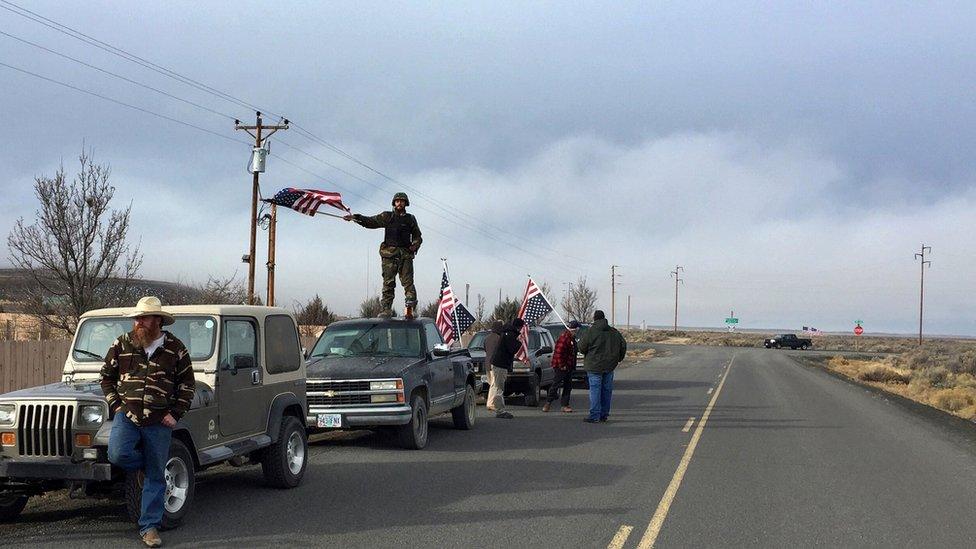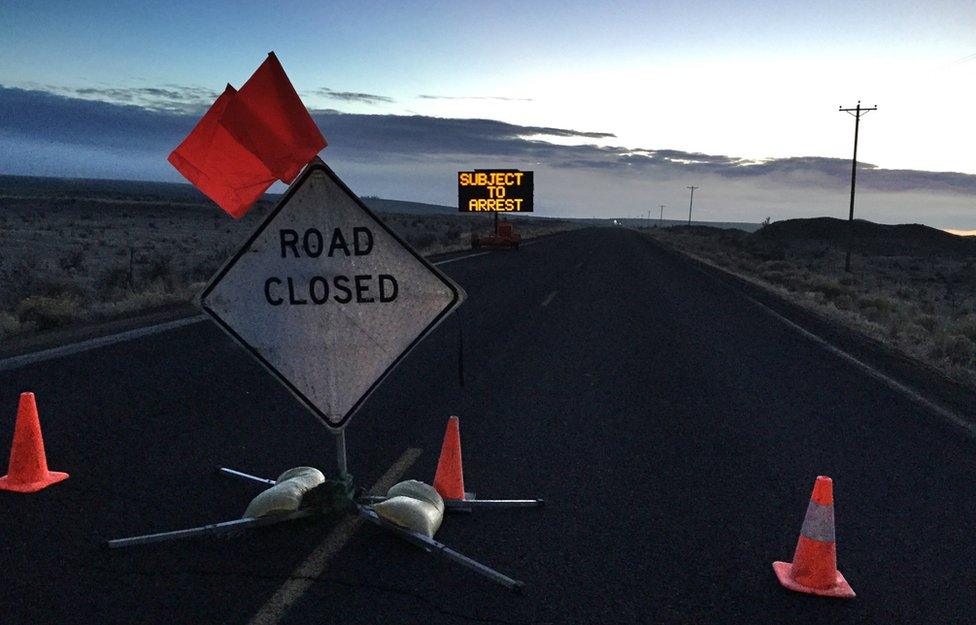Oregon stand-off: Final occupier surrenders after 41 days
- Published

The Malheur Refuge was seized in January, the culmination of a two-decade dispute over grazing rights on federal land
The remaining armed occupiers of a US wildlife sanctuary in the state of Oregon have surrendered, the FBI confirms.
The militia took over the refuge in Oregon on 2 January, protesting against government "interference" in the lives of ranchers in the western US.
The development comes hours after the FBI surrounded the group at the site.
In late January, one protester was shot dead when the FBI and police arrested the leaders of the occupation.
Just before 1000 local time (1800GMT) on Thursday, three of the remaining four militia, Sandy Anderson, 47 of Riggins, Idaho; her husband Sean Anderson, 48 and Jeff Banta, 46 from Yerington, Nevada surrendered and walked into the custody of the FBI.
But David Fry, 27, who remained holed-up, said he was feeling "suicidal". Mr Fry, who is from Blanchester, Ohio, said he "will die a free man".
"Liberty or death," he said, adding "I declare war against the federal government because they have been trampling on my first amendment rights."
On a live broadcast streamed on the internet, Mr Fry described how the others had walked out with hands in the air, holding an American flag.
An hour later, to cries of "hallelujah", the 27-year-old could be heard saying "I'm walking towards them right now," as he too surrendered to the FBI.

Roads leading up to the wildlife reserve were closed after FBI officers moved in on Wednesday
The four had spent their last night at the Malheur National Wildlife Refuge, camping in the grounds around 30 miles south of the city of Burns on the snowy desert plains of Harney County in north-eastern Oregon.
The attempt to resolve the stand-off was brokered by a Republican member of Nevada's state assembly, Michele Fiore, who travelled to the bird reserve to witness the surrender along with a preacher, Franklin Graham.
In the final moments of the siege, activists KrisAnne Hall and Gavin Seim pleaded with Mr Fry to give himself up.
"It has never been the FBI's desire to engage these armed occupiers in any way other than through dialogue," Greg Bretzing, special agent in charge of the FBI in Oregon, said on Wednesday, before the final arrests were made.
FBI agent in charge Greg Bretzing said he was ''grateful'' for a peaceful ending to the stand-off
Mr Fry's arrest brings the 41-day occupation of the federal complex to an end.
The FBI said in a statement that "no one was injured, and no shots were fired" during the arrests on Thursday.
The peaceful end comes after a series of arrests last month that saw 12 people taken into custody, and the group's spokesman, LaVoy Finicum, shot dead during a confrontation with police.
Police said that Finicum was reaching for a pistol when he was shot and killed by the authorities.

Cliven Bundy attended the funeral of Lavoy Finicum in early February
A total of 16 people have been indicted on charges of conspiring to impede federal officers from carrying out their duties through force, intimidation or threats in connection with the stand-off, which was originally sparked by the imprisonment of two local ranchers convicted of arson.
The group's apparent leader, Ammon Bundy, was involved in a previous stand-off with the federal government over grazing rights on his father Cliven Bundy's ranch in neighbouring Nevada.
It emerged on Wednesday that Mr Bundy Sr had been charged in connection with that 2014 dispute, having been detained in Portland, Oregon.
The 69-year-old is reportedly accused of conspiracy, assault on a federal officer, obstruction, weapons charges and other crimes.

The Oregon stand-off explained

How did it begin?
In October, a federal judge ruled the sentences on two Oregon ranchers, Dwight and Steven Hammond, for burning federal land were too short and jailed them for about four years each.
Angered by the ruling, Nevada native Ammon Bundy began a social media campaign backing them and travelled to Burns, Oregon, organising meetings.
His group attracted supporters from across a number of states and Mr Bundy called it Citizens for Constitutional Freedom. On 2 January the armed militiamen took over the Malheur National Wildlife Refuge - and widened the range of demands.
What are the militia's aims?
It is an extension of the Sagebrush Revolution of the 1970s and 1980s that demanded the transfer of federal land in many western states to local control.
Mr Bundy's own father - a Nevada rancher - had been involved in a protest over cattle-grazing rights in 2014. One policy is to try to persuade ranchers to tear up their federal grazing contracts.
Although many local residents are sympathetic with its cause, many also oppose the occupation of the refuge. Even the local ranchers who are serving the longer sentences distanced themselves from the militia.
Are militias legal?
The term has a complex history and generally refers to those outside the official military who can be called on in times of need. The US Constitution refers to the president having command of "militia of several states" and that Congress "can call forth militia" to tackle insurrection and invasion.
Those who form such militias cite the constitution and various references in federal and state law as granting them legality.
- Published5 January 2016

- Published28 January 2016

- Published27 January 2016
